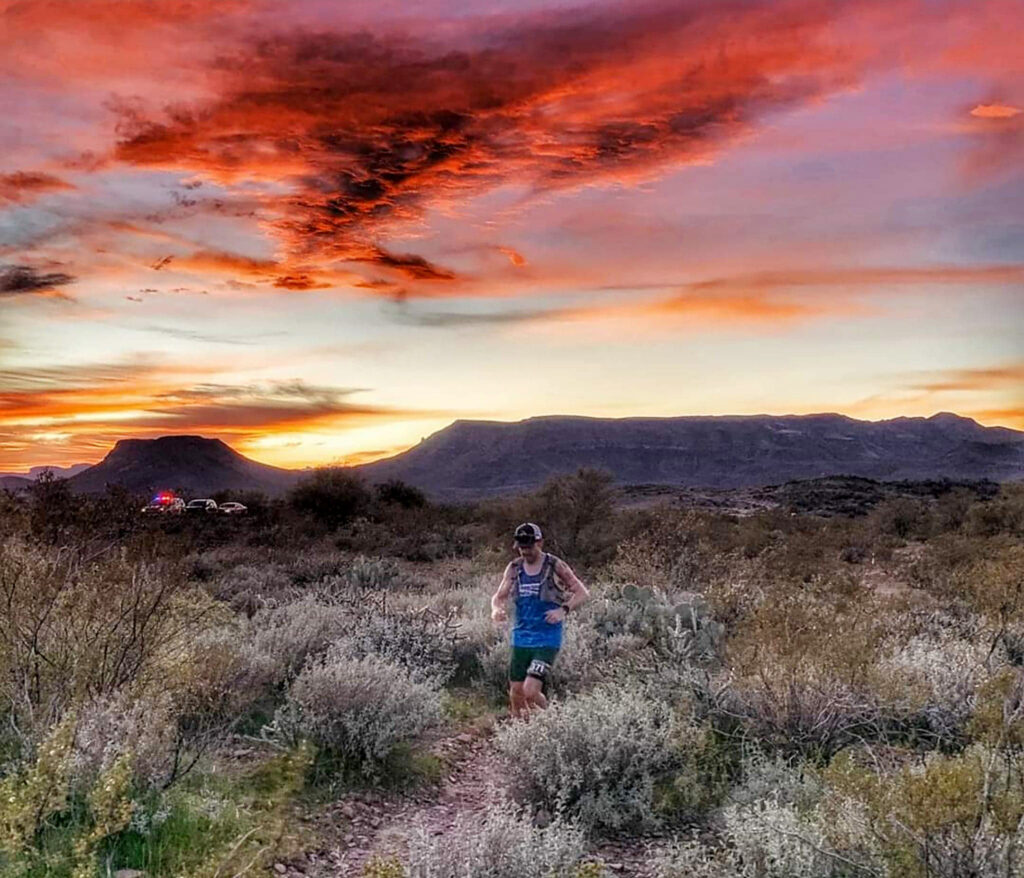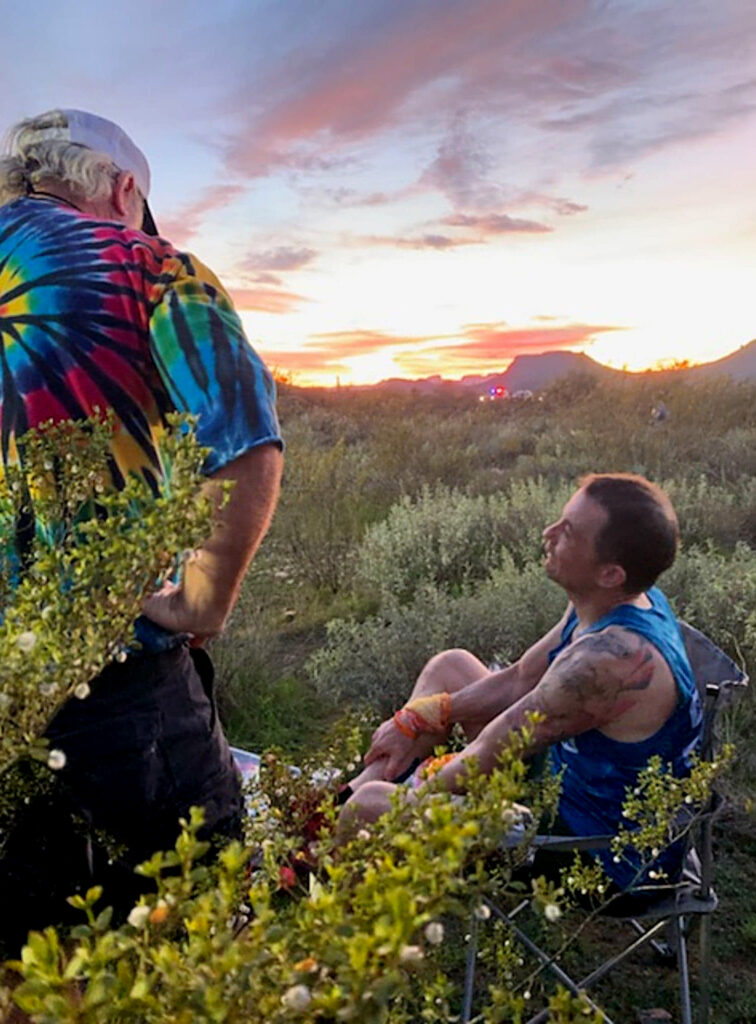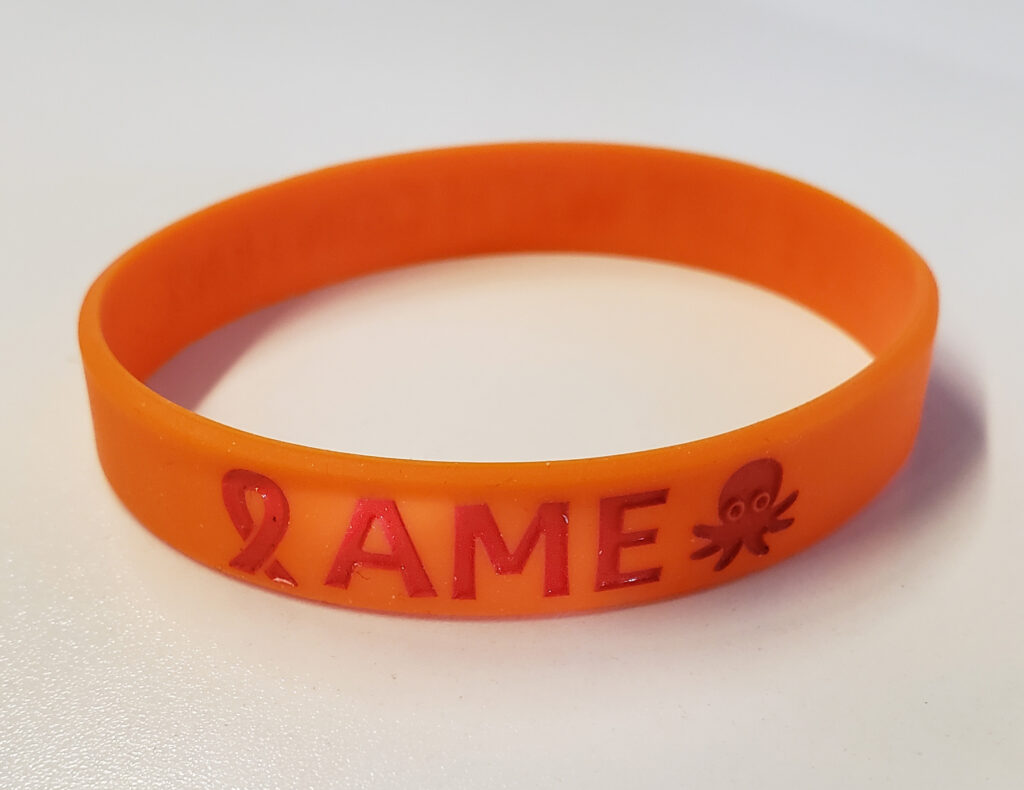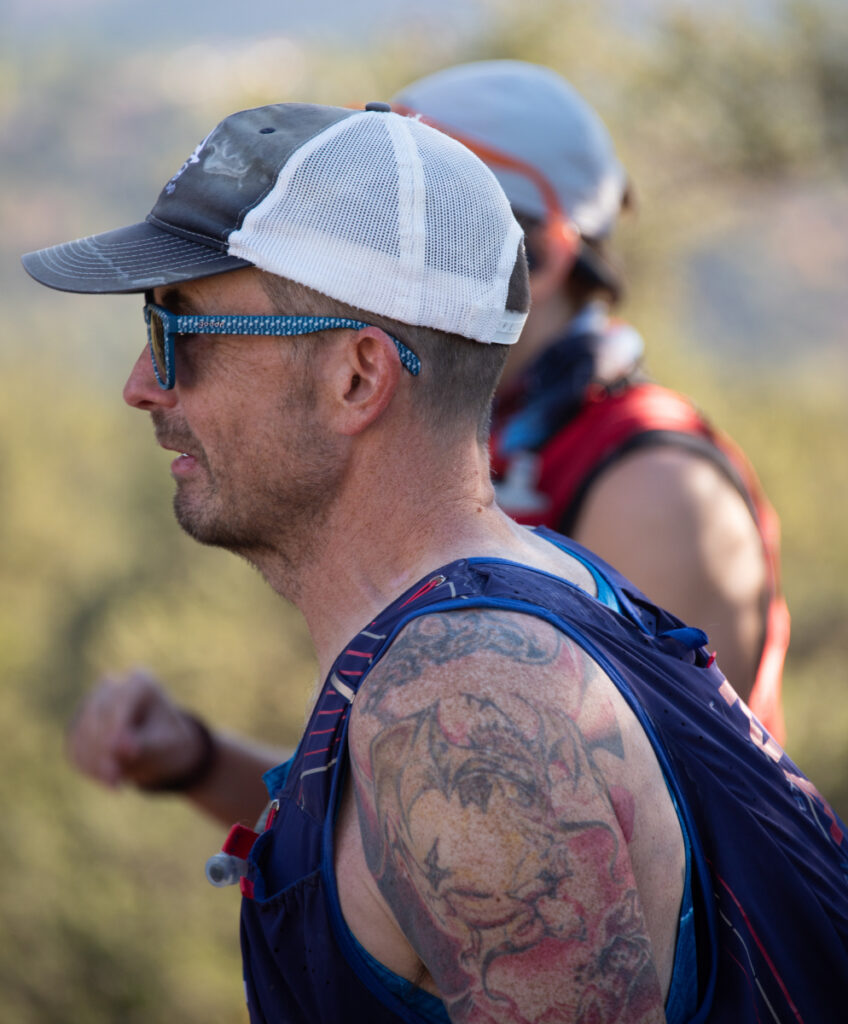
As I sat in the folding camp chair at mile 50 of the Black Canyon 100k, oblivious to the crew working hard to prepare me for the final 12 miles, I began to question why I was here.
My skin burned from the Arizona sun, my stomach warned me what it would do if I continued, and my legs screamed as they tightened into knots, making them almost impossible to extend. That little voice of doubt that had been at bay for most of this beautiful day on the trail was starting to whisper: “You could stop, and no one would care.” Louder: “YOU DON’T HAVE WHAT IT TAKES to finish.” Deafening: “You can MAKE THIS PAIN ALL GO AWAY!”
I slowly dropped my head in near defeat while the aid station scene whirled around me at a breakneck pace, much like the time-lapse video of a busy street corner. The words “Run for Dana Farber” emblazoned across my race-worn singlet caught my eye. As curiosity guided my gaze further, I moved to my wrist. The ring of orange rubber engraved in red with the initials ‘AME’ bookended by a ribbon and an octopus jumped out at me. I rotated my wrist…’LIVE LIFE WITH CONTENT’… finished off the message. I watched the world around me slow down (or was I speeding up?) as I studied each word. This was why I was here. This was my purpose. “Let’s finish this thing!”

Negativity and doubt can be a very real and sobering part of running. It creeps up not just during races, but grabs hold of us on a Saturday morning at 5 a.m. The chirping alarm reminding us that we need to venture out into the cold to get our miles in. Mix in the stresses of life, loss of focus, and health factors that each alone can all drain the fun out of a run(s) and turn it into a chore.
This past year was especially taxing. Canceled races, runs with friends have became scarce, and the running landscape has become a lonely place (I will not even delve into the social and economic pressures of the year).
But collectively, at one point or another over our running ‘careers,’ we have lost our purpose for running. 4 years ago, you were more likely to find me on a local barstool in Pasadena, CA, than on a trail or road. I had no purpose, and in my selfishness, I was not helping anyone. (Do not fret. I am getting to the positive stuff. That is why we are here, right?)
Then, I received a mailer from a national organization that trained people to complete a marathon and raise money for a worthy cause. Something about it resonated with me and my desire to help others. I had recently learned that my cousin had been diagnosed with Leukemia at the age of 25, and it seemed like the perfect opportunity to give back. I signed up to run the Las Vegas Marathon and committed to raising $1,400. The thought of either of these feats was daunting and scary — and let me tell you, it was not pretty — but what has happened since that fateful day is beyond what I could have even imagined.

You, as a runner, inspire others. Yes, our friends, families, and loved ones tease us about the never-ending stories we tell of our latest running adventure, or the way our new shoes gripped that epic climb. They do not quite get why we do it, but we still inspire them. This inspiration is not that different from the one we feel about fellow runners in our running communities.
I bet you did not even realize that you already have a key component to beginning a fundraising campaign in place. This base support system will be particularly important and will be the group that will be the first to hear about your cause and what you are doing for it. They will also be the first to give to your fundraiser and help spread the word. There is no doing this alone.
“When (looking) at functional MRIs of subjects who gave to various charities, scientists have found that giving stimulates the mesolimbic pathway, which is the reward center of the brain – releasing endorphins and creating what is known as the “helper’s high” (source: “Why Giving is Good”). You will certainly be giving of yourself. Couple this with a good runner’s high and you can forget that double espresso. When choosing a cause, it is okay to begin with something that you do not have a personal or emotional connection with. The passion will grow with each step you take, no matter how you begin. You will be motivated and humbled by the strength and resolve of the people you meet. The threads from stories of your journey and the ones from theirs will weave together to form a singular tapestry.

You will never run alone again. The ones you are helping will always be right there by your side. They pick you up out of that chair (or even bed at 5 a.m.) because your moments of pain and fatigue pale in comparison to the struggles that they have unrelentingly endured, and you give them hope and knowledge that they are not alone in their fight. This may be a very romantic and emotional way to explain why you might want to fundraise through running, but this is the purpose I am speaking of. The passion is not found in a list on a website (although I highly suggest researching the logistics of setting up a fundraiser and researching different organizations) but rather in the intangible space between the details.
My first coach, inspirational mentor, and good friend Kiley Akers summarized it perfectly in a post on Facebook:
“As a coach with Team in Training, athletes would sometimes have trepidation in asking others for fundraising dollars. I understood that and could/can relate. I would often say (and it is the truth) that the money raised may save the life of a stranger, a friend, a family member…. or even yourself….”
Kiley has been raising money and helping others for more than a decade in memory of his father and has been successfully battling lung cancer after his diagnosis last year…. by using a drug created through research that his fundraising helped develop.

As for my cousin who sparked the fire that started this fundraising journey, she passed from this world on November 8, 2019, at the age of 29. She courageously battled a rare form of Acute Myeloid Leukemia over the four long years with fierce resolve and a smile. Her name was Annie Mac Evans (-ribbon-AME-octopus-), and she has been with me for every mile I have run and will ever run. She is my strength, she is my resolve, and she is my purpose.
TJ Gardner lives with his wife and 2-year-old son in Phoenix, AZ. He is an avid ultra-runner and continues to raise money for Dr. Soiffer’s Leukemia research at the Dana Farber Cancer Institute in Boston, MA, in memory of Annie Mac Evans.
Check out Danafarber.jimmyfund.org/goto/Together_We_Endure to learn more and follow TJ’s journey on Instagram @manwiththegoldenhat/reach out to him if you have questions about using running as a fundraising tool.
Works Cited:
“Why Giving Is Good For Your Health.” Health Essentials, Cleveland Clinic, 30 Nov. 2020, health.clevelandclinic.org/why-giving-is-good-for-your-health.
@KileyAkers “Here’s to a good Friday.” Facebook, 29 Jan. 2021, 7:48 p.m., facebook.com/kiley.akers/posts/10157572775021087

Wow ! This is very inspiring ❤️ Thank you for your Amazing efforts to help
Others .